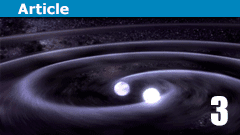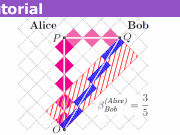Does Gravity Gravitate: The Wave
In the first two posts in this series, we looked at different ways of interpreting the question “does gravity gravitate?” We left off at the end of the last post with an open question: what do the various “mass integrals” look like in a spacetime where gravitational waves are being emitted? Let’s look at that question now.
The key difference between GWs and other types of radiation is that GWs have zero stress-energy. They are oscillations in the curvature of spacetime. This fact makes it tempting to conclude that GWs can’t carry energy at all; in fact, many physicists who studied GR in the 1950s and 1960s thought this. The basic argument goes like this: the “source” in the EFE is on the RHS, but GWs can be present when the RHS of the EFE is zero, i.e., when there is no “source”. By analogy with EM waves, that should mean that GWs can’t carry any “source” along with them, just as EM waves can’t carry any charge. But the “charge” associated with gravity is just energy (more precisely, stress-energy), so it seems like GWs should not be able to carry any energy.
However tempting this line of reasoning is, though, it isn’t valid. We can see this by a simple thought experiment, inspired by Feynman’s response at a gravity conference when he saw so many people struggling with this issue: “This is what comes from looking for conserved tensors, etc., instead of asking, can the waves do work?” Suppose we have gravitational waves passing through a certain region of empty space, which we will idealize as plane waves for this case (we assume we are very far from the source and that the waves are weak enough that no nonlinearities, i.e., no self-interactions, can be detected). We place an object transverse to the direction of wave propagation; for example, we could place a flat plate of some material such that it lies in a plane perpendicular to the wave vector. What will happen? It is straightforward to show that the wave oscillations will induce vibrations in the object which will heat it up; i.e., the waves will do work on the object, adding energy to it. That means the waves themselves must be carrying energy.
This is a local view (or at least, quasi-local–we’ll see below that the energy carried by GWs can’t really be localized), but there is also a global view. Consider a spacetime containing GWs, such as a binary pulsar spacetime, and assume that there is *no* other radiation present besides the GWs (which is *not* true for a real binary pulsar, but which is a valid idealization for our purposes here). We can still do the same comparison we did for the case of EM radiation in the previous post, and we will find the same result: the ADM mass and Bondi mass of the system will *not* be the same. The ADM mass of the spacetime will include the energy carried by the GWs, but the Bondi mass will not. So we can separate out, globally, the energy carried away by GWs from the gravitating mass that remains behind.
But what about that line of reasoning that we gave above? Where, exactly, does it break down? After all, local conservation of the SET still holds; the covariant divergence of the SET is still zero everywhere. So where does the energy get “transferred” from the matter (which has nonzero SET) to the GWs (which have zero SET)? And how can that happen without violating the local conservation law?
Consider an idealized binary pulsar system again. We have two neutron stars orbiting each other, and as GWs are emitted, the orbital parameters slowly change: the stars get closer to each other and their orbital speeds increase. The net effect is an energy decrease for the system consisting of the two stars only (remember that we assumed for our purposes here that there was no radiation present other than GWs), and this can be understood, qualitatively, in Newtonian terms: the reduction in potential energy due to the stars getting closer is larger than the increase in kinetic energy due to the increase in orbital speeds. (If you actually do the math, you will see that this follows from Kepler’s Third Law.) However, the change in orbital parameters also means a change in the RHS of the EFE, because the relative positions of the “sources”–the regions of nonzero SET in the interiors of the two neutron stars–have changed. This shows up as a change in the metric coefficients. This change isn’t as simple as a slow reduction of [itex]M[/itex] in the Schwarzschild line element would be, but its effect is similar: if we put a test object in orbit at a large distance from the binary pulsar system, and measure its orbital parameters, the “gravitating mass” of the system that we obtain will slowly decrease as GWs pass by us on their way out to infinity.
If we try to localize exactly “where” the change in metric coefficients is being triggered from, though, there is no answer. Locally, the covariant divergence of the SET is zero at every event; there are time and space variations in the metric, and they are driven by time and space variations in the “source” (because the two pulsars are orbiting each other), but those variations are constrained by the local conservation law. It is only when you look on a larger scale (a scale at least as large as the wavelength of the GWs being emitted, which for a typical binary pulsar is pretty large, on the order of the orbital radius) that you can see a pattern in the time and space variations in the metric that tells you that GWs are being emitted and are carrying away energy, globally, from the binary system.
So we have a third way of interpreting our title question, which leads to the answer “yes”: if “gravity” is interpreted as “spacetime”, and “gravitate” is interpreted as “can store and propagate energy”, then yes, spacetime can store and propagate energy: gravity does gravitate.
Postscript
You may be wondering about one loose end: what about the Komar mass of a system that is emitting radiation? That’s where the comment I made in the previous post, about the Komar mass being applicable in a somewhat different class of spacetimes, comes in. Spacetimes where radiation is present can be asymptotically flat, so the ADM and Bondi masses can still be defined and computed. But spacetimes where radiation is present *cannot* be stationary: they cannot have a timelike Killing vector field. That means the Komar mass simply can’t be properly defined for such spacetimes. There may be ways to adjust the Komar mass definition, for example by using the total 4-momentum of the spacetime as defined in the asymptotically flat region to find a timelike unit vector to plug into the Komar mass integral. But that’s a subject for (possibly) another post.
- Completed Educational Background: MIT Master’s
- Favorite Area of Science: Relativity








Leave a Reply
Want to join the discussion?Feel free to contribute!